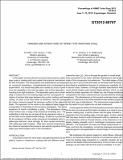| dc.contributor.author | Day, I. J. | |
| dc.contributor.author | Pullan, Graham | |
| dc.contributor.author | Young, Albert M. | |
| dc.contributor.author | Greitzer, Edward M | |
| dc.contributor.author | Spakovszky, Zoltan S | |
| dc.date.accessioned | 2018-06-19T12:23:11Z | |
| dc.date.available | 2018-06-19T12:23:11Z | |
| dc.date.issued | 2012-06 | |
| dc.identifier.isbn | 978-0-7918-4474-8 | |
| dc.identifier.uri | http://hdl.handle.net/1721.1/116390 | |
| dc.description.abstract | In this paper we describe the structures that produce a spiketype route to rotating stall and explain the physical mechanism for their formation. The descriptions and explanations are based on numerical simulations, complemented and corroborated by experiments. It is found that spikes are caused by a loss of pressure rise capability in the rotor tip region, due to flow separation resulting from high incidence. The separation gives rise to shedding of vorticity from the leading edge and the consequent formation of vortices that span between the suction surface and the casing. As seen in the rotor frame of reference, near the casing the vortex convects toward the pressure surface of the adjacent blade. The approach of the vortex to the adjacent blade triggers a separation on that blade so the structure propagates. The above sequence of events constitutes a spike. The simulations show shed vortices over a range of tip clearances including zero. The implication is that they are not part of the tip clearance vortex, in accord with recent experimental findings. Evidence is presented for the existence of these vortex structures immediately prior to spike-type stall and, more strongly, for their causal connection with spike-type stall inception. Data from several compressors are shown to reproduce the pressure and velocity signature of the spike-type stall inception seen in the simulations. | en_US |
| dc.publisher | ASME International | en_US |
| dc.relation.isversionof | http://dx.doi.org/10.1115/GT2012-68707 | en_US |
| dc.rights | Article is made available in accordance with the publisher's policy and may be subject to US copyright law. Please refer to the publisher's site for terms of use. | en_US |
| dc.source | ASME | en_US |
| dc.title | Origins and Structure of Spike-Type Rotating Stall | en_US |
| dc.type | Article | en_US |
| dc.identifier.citation | Pullan, G., A. M. Young, I. J. Day, E. M. Greitzer, and Z. S. Spakovszky. “Origins and Structure of Spike-Type Rotating Stall.” Volume 8: Turbomachinery, Parts A, B, and C (June 11, 2012).. | en_US |
| dc.contributor.department | Massachusetts Institute of Technology. Department of Aeronautics and Astronautics | en_US |
| dc.contributor.department | Massachusetts Institute of Technology. Department of Electrical Engineering and Computer Science | en_US |
| dc.contributor.mitauthor | Pullan, Graham | |
| dc.contributor.mitauthor | Young, Albert M. | |
| dc.contributor.mitauthor | Greitzer, Edward M | |
| dc.contributor.mitauthor | Spakovszky, Zoltan S | |
| dc.relation.journal | Volume 8: Turbomachinery, Parts A, B, and C | en_US |
| dc.eprint.version | Final published version | en_US |
| dc.type.uri | http://purl.org/eprint/type/ConferencePaper | en_US |
| eprint.status | http://purl.org/eprint/status/NonPeerReviewed | en_US |
| dc.date.updated | 2018-03-20T16:48:49Z | |
| dspace.orderedauthors | Pullan, G.; Young, A. M.; Day, I. J.; Greitzer, E. M.; Spakovszky, Z. S. | en_US |
| dspace.embargo.terms | N | en_US |
| dc.identifier.orcid | https://orcid.org/0000-0001-9625-1020 | |
| dc.identifier.orcid | https://orcid.org/0000-0003-2167-9860 | |
| mit.license | PUBLISHER_POLICY | en_US |
